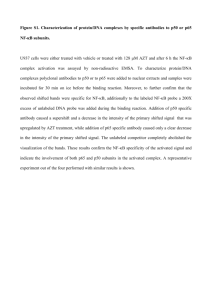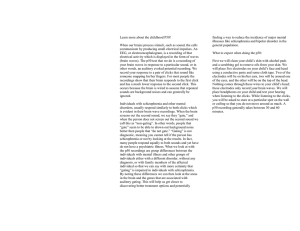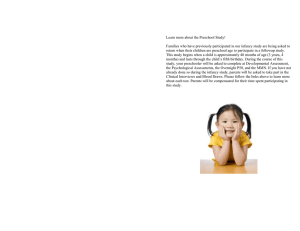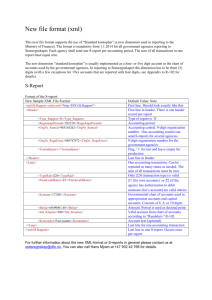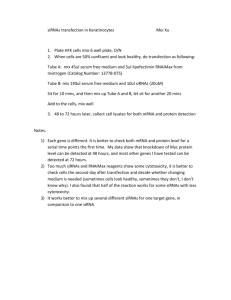RNA Interference Shows Critical Requirement for NF
advertisement
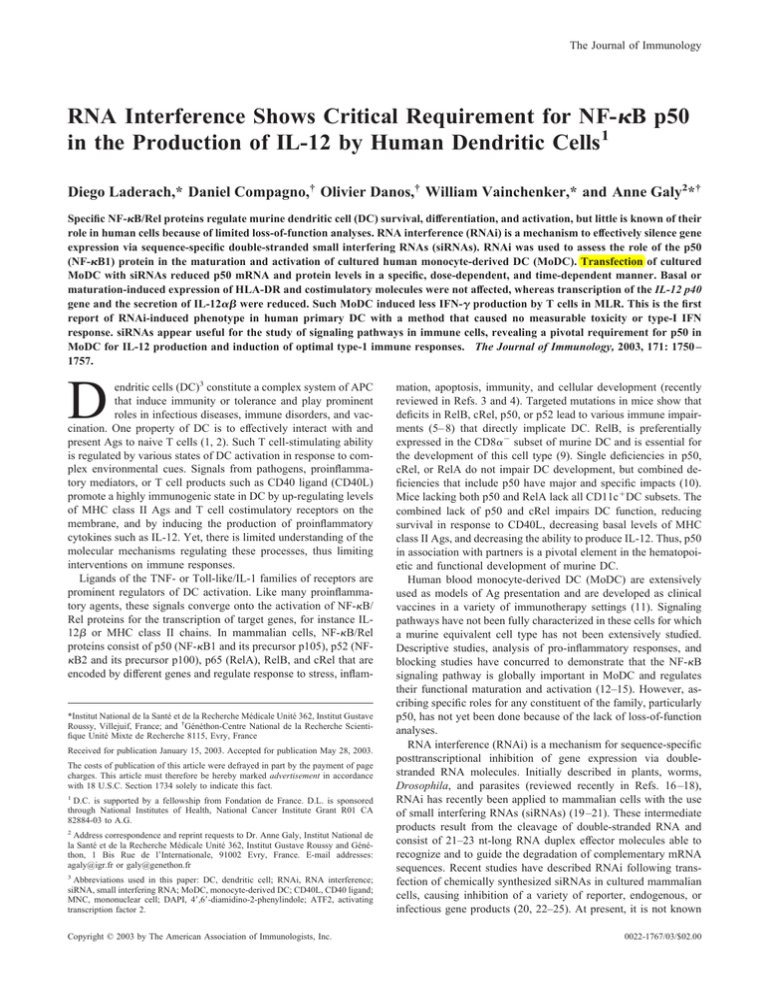
The Journal of Immunology RNA Interference Shows Critical Requirement for NF-B p50 in the Production of IL-12 by Human Dendritic Cells1 Diego Laderach,* Daniel Compagno,† Olivier Danos,† William Vainchenker,* and Anne Galy2*† Specific NF-B/Rel proteins regulate murine dendritic cell (DC) survival, differentiation, and activation, but little is known of their role in human cells because of limited loss-of-function analyses. RNA interference (RNAi) is a mechanism to effectively silence gene expression via sequence-specific double-stranded small interfering RNAs (siRNAs). RNAi was used to assess the role of the p50 (NF-B1) protein in the maturation and activation of cultured human monocyte-derived DC (MoDC). Transfection of cultured MoDC with siRNAs reduced p50 mRNA and protein levels in a specific, dose-dependent, and time-dependent manner. Basal or maturation-induced expression of HLA-DR and costimulatory molecules were not affected, whereas transcription of the IL-12 p40 gene and the secretion of IL-12␣ were reduced. Such MoDC induced less IFN-␥ production by T cells in MLR. This is the first report of RNAi-induced phenotype in human primary DC with a method that caused no measurable toxicity or type-I IFN response. siRNAs appear useful for the study of signaling pathways in immune cells, revealing a pivotal requirement for p50 in MoDC for IL-12 production and induction of optimal type-1 immune responses. The Journal of Immunology, 2003, 171: 1750 – 1757. D endritic cells (DC)3 constitute a complex system of APC that induce immunity or tolerance and play prominent roles in infectious diseases, immune disorders, and vaccination. One property of DC is to effectively interact with and present Ags to naive T cells (1, 2). Such T cell-stimulating ability is regulated by various states of DC activation in response to complex environmental cues. Signals from pathogens, proinflammatory mediators, or T cell products such as CD40 ligand (CD40L) promote a highly immunogenic state in DC by up-regulating levels of MHC class II Ags and T cell costimulatory receptors on the membrane, and by inducing the production of proinflammatory cytokines such as IL-12. Yet, there is limited understanding of the molecular mechanisms regulating these processes, thus limiting interventions on immune responses. Ligands of the TNF- or Toll-like/IL-1 families of receptors are prominent regulators of DC activation. Like many proinflammatory agents, these signals converge onto the activation of NF-B/ Rel proteins for the transcription of target genes, for instance IL12 or MHC class II chains. In mammalian cells, NF-B/Rel proteins consist of p50 (NF-B1 and its precursor p105), p52 (NFB2 and its precursor p100), p65 (RelA), RelB, and cRel that are encoded by different genes and regulate response to stress, inflam- *Institut National de la Santé et de la Recherche Médicale Unité 362, Institut Gustave Roussy, Villejuif, France; and †Généthon-Centre National de la Recherche Scientifique Unité Mixte de Recherche 8115, Evry, France Received for publication January 15, 2003. Accepted for publication May 28, 2003. The costs of publication of this article were defrayed in part by the payment of page charges. This article must therefore be hereby marked advertisement in accordance with 18 U.S.C. Section 1734 solely to indicate this fact. 1 D.C. is supported by a fellowship from Fondation de France. D.L. is sponsored through National Institutes of Health, National Cancer Institute Grant R01 CA 82884-03 to A.G. 2 Address correspondence and reprint requests to Dr. Anne Galy, Institut National de la Santé et de la Recherche Médicale Unité 362, Institut Gustave Roussy and Généthon, 1 Bis Rue de l’Internationale, 91002 Evry, France. E-mail addresses: agaly@igr.fr or galy@genethon.fr 3 Abbreviations used in this paper: DC, dendritic cell; RNAi, RNA interference; siRNA, small interfering RNA; MoDC, monocyte-derived DC; CD40L, CD40 ligand; MNC, mononuclear cell; DAPI, 4⬘,6⬘-diamidino-2-phenylindole; ATF2, activating transcription factor 2. Copyright © 2003 by The American Association of Immunologists, Inc. mation, apoptosis, immunity, and cellular development (recently reviewed in Refs. 3 and 4). Targeted mutations in mice show that deficits in RelB, cRel, p50, or p52 lead to various immune impairments (5– 8) that directly implicate DC. RelB, is preferentially expressed in the CD8␣⫺ subset of murine DC and is essential for the development of this cell type (9). Single deficiencies in p50, cRel, or RelA do not impair DC development, but combined deficiencies that include p50 have major and specific impacts (10). Mice lacking both p50 and RelA lack all CD11c⫹DC subsets. The combined lack of p50 and cRel impairs DC function, reducing survival in response to CD40L, decreasing basal levels of MHC class II Ags, and decreasing the ability to produce IL-12. Thus, p50 in association with partners is a pivotal element in the hematopoietic and functional development of murine DC. Human blood monocyte-derived DC (MoDC) are extensively used as models of Ag presentation and are developed as clinical vaccines in a variety of immunotherapy settings (11). Signaling pathways have not been fully characterized in these cells for which a murine equivalent cell type has not been extensively studied. Descriptive studies, analysis of pro-inflammatory responses, and blocking studies have concurred to demonstrate that the NF-B signaling pathway is globally important in MoDC and regulates their functional maturation and activation (12–15). However, ascribing specific roles for any constituent of the family, particularly p50, has not yet been done because of the lack of loss-of-function analyses. RNA interference (RNAi) is a mechanism for sequence-specific posttranscriptional inhibition of gene expression via doublestranded RNA molecules. Initially described in plants, worms, Drosophila, and parasites (reviewed recently in Refs. 16 –18), RNAi has recently been applied to mammalian cells with the use of small interfering RNAs (siRNAs) (19 –21). These intermediate products result from the cleavage of double-stranded RNA and consist of 21–23 nt-long RNA duplex effector molecules able to recognize and to guide the degradation of complementary mRNA sequences. Recent studies have described RNAi following transfection of chemically synthesized siRNAs in cultured mammalian cells, causing inhibition of a variety of reporter, endogenous, or infectious gene products (20, 22–25). At present, it is not known 0022-1767/03/$02.00 The Journal of Immunology whether this technique can be effectively applied to regulate gene expression in primary human DC. In this study we report that RNAi is feasible in primary human MoDC and can be used to specifically knock down the expression of p50, revealing its role in the production of IL-12 and induction of optimal type-1 T cell response, but not in the up-regulation of cell surface molecules on DC. Materials and Methods Source of cells G-CSF-mobilized peripheral blood and umbilical cord blood samples were obtained from Gustave Roussy Institute (Villejuif, France) or Tenon Hospital (Paris, France) in accordance with institutional guidelines. Mononuclear cells (MNC) were isolated by centrifugation over Ficoll (Amersham Pharmacia Biotech, Piscataway, NJ), and when needed they were cryopreserved in liquid nitrogen using a 10% DMSO solution. Culture of DC Adherent monocytes were obtained by incubating MNC onto plastic (2 ⫻ 106 cells/ml/well in 24-well tissue culture plates) in RPMI medium with 10% FBS and antibiotics (R10) (26) in a humidified atmosphere at 37°C, 5% CO2 for 2 h. Nonadherent cells were removed by washing, and R10 medium containing GM-CSF (25 ng/ml; Immunex, Seattle, WA) and IL-4 (10 ng/ml; R&D Systems, Minneapolis, MN) was added for 4 days to produce immature DC. 1751 Western blot After transfection and overnight activation, 5 ⫻ 105 DC were lysed in 50 mM Tris, 150 mM NaCl, 1% Triton X 100, 1% sodium deoxycholate, 0.1% SDS, and 5 mM EDTA. Protease inhibitor mixture and pellets were kept at ⫺80°C until used. Protein amounts were determined with the Bio-Rad DC Protein Assay (Bio-Rad, Hercules, CA). For each condition, 10 g of protein was separated on 10% polyacrylamide gels and transferred to nitrocellulose sheets. Binding with polyclonal goat Abs specific for p50 (Sc1191, 1/100 dilution) or for -actin (Sigma-Aldrich, St. Louis, MO) was revealed with peroxidase-conjugated rabbit anti-goat Abs (1/5000 dilution) using the ECL Western Blotting Analysis System (Amersham Pharmacia Biotech). Immunofluorescence detection A total of 0.5–1 ⫻ 105 cells were spun on glass coverslips and fixed with 4% paraformaldehyde for 10 min at 4°C. Cells were washed twice in PBS and then permeabilized in saponin buffer (0.1% saponin, 0.2% BSA, 0.02% sodium azide, in PBS). Nonspecific Fc binding was blocked by 10 min of incubation with human ␥-globulin (1 mg/ml) and 1/100 dilution of donkey serum (Sigma-Aldrich). Polyclonal goat Abs specific for NF-B p50 (Sc1191) (Santa Cruz Biotechnology, Santa Cruz, CA) were used at 5 g/ml and revealed by a FITC conjugated donkey anti-goat secondary reagent (Jackson ImmunoResearch Laboratories, West Grove, PA) used at 1/400 dilution in saponin buffer. Cell nuclei were stained with 4⬘,6⬘-diamidino2-phenylindole (DAPI) included in the Vectashield mounting medium (Abcys, Paris, France). Cells were observed under epifluorescence microscopy, and cells expressing, or not, p50 protein in the nucleus above background stain were enumerated after analysis of ⬎100 cells. siRNAs and electroporation DNA-binding ELISA The 21-nt-long interfering RNA duplexes with two 3⬘-end overhang dT nucleotides in the antisense strand were synthesized as reported (20, 22). The sequences of the antisense strands of the siRNAs were as follows: anti-p50 siRNA: 5⬘-AGU CCA GGA UUA UAG CCC CdTdT (MWG Biotec, Ebersberg, Germany or Dharmacon, Lafayette, CO); control I-siRNA, an irrelevant siRNA with random nucleotides and no known specificity: 5⬘-ACG GGG GGC CCU UAA AAC AdTdT (MWG Biotec); and control II-siRNA, an irrelevant siRNA with random nucleotides and a GC ratio close to that of anti-p50 siRNA: 5⬘-UGU UUU AAG GGC CCC CCG UdTdT (Dharmacon and Genset, Evry, France). Transfection of siRNAs was conducted by electroporation using an ECM 830 square wave electroporation system (BTX, San Diego, CA). Briefly, 4 ⫻ 105 cells were washed twice in PBS and placed in 4-mm gap cuvettes in the presence of oligonucleotides, subjected to 5 cycles of 20 V, 10 ms separated by 500-ms gaps in electroporation buffer (120 mM KCl, 0, 15 mM CaCl2, 10 mM K2HPO4/KH2PO4, 25 mM HEPES, 2 mM EGTA, 5 mM MgCl2, 50 mM glutathione, 2 mM ATP, pH 7.6). Cells were washed again and transferred to culture medium. DNA binding activity by p65, p50, and cRel, as well as c-Fos, CREB-1, and activating transcription factor 2 (ATF2) were detected by ELISA using the Mercury Transfactor Profiling kit (Inflammation 1; Clontech Laboratories, Palo Alto, CA). MoDC were transfected, and 3 days later they were activated with CD40L and IL-1. A total of 2 g (nuclear) or 3 g (cytosolic) proteins were tested for each transcription factor binding activity following manufacturer’s instructions. Color development of tetramethylbenzidine substrate was measured at 630 nm using a Dynatech MR5000 plate reader (Dynatech Laboratories, Chantilly, VA). DC activation MoDC were harvested at indicated times after transfection, washed twice in cytokine-free medium, and incubated at concentrations of 5 ⫻ 105 cells/ml with human recombinant CD40L trimer (1 g/ml; a kind gift from Immunex), and IL-1␣ (3–10 ng/ml; R&D Systems) for 18 h. Cells were harvested, and supernatant fluid was collected and stored frozen at ⫺20°C until tested. RT-PCR analysis Total RNA was extracted from 5 ⫻ 105 DC using TRIzol reagent (Invitrogen, Cergy Pontoise, France). cDNA was synthesized using random hexamers, dNTP mixture, rRNAs in ribonuclease inhibitor, and SuperScript II Rnase H-Reverse Transcriptase (Invitrogen, San Diego, CA). PCR amplification was conducted in 50 l containing 1–5 l of cDNA, 1.5 mM MgCl2, dNTP mixture (0.2 mM each dNTP), 0.5 M each oligonucleotide primer, and 2 U of Taq DNA polymerase. Primers used were: p50 sense 5⬘-CTGGAAGCACGAATGACAGA, p50 anti-sense 5⬘-TTTCAAGTTG GATGCATTGG; cRel sense 5⬘-GCACAGCACAGACAACAACC, cRel antisense 5⬘-TCAGCTGTTTTTCAGGGACA (Invitrogen). -Actin and human IL-12 (p40) primer pairs were from Ambion (Austin, TX) and R&D Systems, respectively. Amplification steps consisted of 35 cycles of denaturation at 94°C for 40 s, annealing at 55°C (-actin, p50, and cRel) or 57°C (IL-12p40) for 40 s, and extension at 72°C for 40 s using a DNA cycler (PerkinElmer, Wellesley, MA). PCR products (expected size 297 bp for p50, 299 bp for c-Rel, 294 bp for -actin, and 559 bp for IL-12 p40) were analyzed on 2% agarose gel electrophoresis stained with ethidium bromide. Flow cytometric analysis Directly conjugated mouse mAbs, including FITC-conjugated or APCconjugated anti-HLA-DR, PE-conjugated anti-human CD80, anti-CD83, anti-CD86 (BD PharMingen, San Diego, CA), anti CD1a (Caltag Laboratories, Burlingame, CA), and FITC-conjugated anti CD14 (3C10-1E12) were used according to a procedure described previously for detection of cell surface or intracellular Ags (26). Detection of surface HLA-DR and intracellular CD83 was done by staining first for HLA-DR, then fixation, permeabilization, and intracellular staining for CD83. Cellular staining was measured on a FACSCalibur instrument (BD Biosciences, San Jose, CA), and data were analyzed using CellQuest or WinMDI (version 2.8) software, with results expressed as percentages of cells staining above background staining obtained with irrelevant mAbs. Purification of T cells and MLR Purified naive cord blood T cells (⬎95% CD3⫹ T cells) were prepared by negative selection. MNC were incubated with mAbs specific for glycophorin A (10F7 MN), CD14 (3C10-1E12), CD32 (IV3), CD11b (OKM1), and CD40 (G28-5) (American Type Culture Collection, Manassas, VA) to remove red blood cells, phagocytes, B cells, and monocytes (Dynal Biotech, Lake Success, NY). Magnetic bead selection was repeated after the addition of anti-CD20 and anti-HLA-DR mAbs (Caltag Laboratories) to further remove B cell and APCs. MLR was set up by culturing purified naive T cells (5 ⫻ 104 cells/0.2 ml of R10 medium per well in triplicate) with various concentrations of allogeneic transfected DC obtained ⬃30 h after transfection with the various siRNAs. Four to six days after initiation of MLR, a fraction of culture medium was harvested to measure the production of IFN-␥ by ELISA. Then, 1 Ci of [3H]thymidine (NEN, Boston, MA) was added to each well during the last 10 h of culture to measure [3H]thymidine incorporation using a liquid scintillation counter. ELISA IL-12p70 (␣), IL-10, and IFN-␥ were measured in culture medium using the OptEIA ELISA sets according to manufacturer’s instructions (BD PharMingen). Lower limits of detection were 8, 8, and 4 pg/ml, respectively. Human interferon-␣ levels were determined using specific ELISA 1752 kit (BioSource International, Camarillo, CA). The lower limit of detection was 25 pg/ml. Results Specific reduction of NF-B p50 mRNA and protein in immature DC We used RNAi to assess the role of p50 in human MoDC because it is not known whether this constituent, which can either homodimerize or heterodimerize with RelB or cRel, has a specific role in human MoDC development. Transfection of small doublestranded RNA duplexes was tested as a way of performing lossof-function analysis in human MoDC in vitro. SiRNAs specific for human p50 mRNA were designed as described (20), ensuring that they lacked significant sequence homologies by standard BLAST search with other known genes, including related family members. Irrelevant siRNAs with random sequences were used as specificity controls. Immature human MoDC were prepared by culture of adherent mobilized peripheral blood monocytes with GM-CSF and IL-4 and were electroporated with 150 nM of anti-p50 or control siRNAs. The choice of dose was based on preliminary experiments in fibroblast cell lines and based on reported methods for RNAi in cultured cell lines (22). Twenty-four hours after transfection, RTPCR analysis showed strong and specific down-regulation of p50 mRNA levels in cells treated with anti-p50 siRNAs, but not with control-irrelevant siRNA or in the absence of siRNA (Fig. 1A). Unlike p50, mRNAs of -actin or of the family member cRel were not strongly affected. A separate, representative experiment shows the down-regulation of p50 protein by Western blot analysis of whole cell protein extracts (Fig. 1B), being about half the amount of untreated cells and about a third of those transfected with no siRNA or irrelevant siRNAs. These results show that p50 protein and mRNA can be effectively inhibited by transfection of siRNAs in cultured MoDC. Lack of nonspecific toxicity and lack of induction of type-1 IFN Double stranded RNA is known to elicit type-I IFN response in mammalian cells, leading to nonspecific arrest in transcription and cell death. However, because of their small size (⬍30 nt), siRNAs reportedly fail to activate the IFN-induced protein kinase R (27) and do not elicit a type-I IFN response in mammalian cells (21). However, unlike other cell types, MoDC may be particularly apt at recognizing double-stranded RNA via the expression of Toll-like receptor 3 (28), prompting us to assess toxicity or type-I IFN response. Electroporation of DC with control or anti-p50 siRNAs did not induce significant mortality with ⬎90% of the cells, excluding trypan blue measured in seven experiments (data not shown). Using an ELISA specific for IFN-␣ and a bioassay measuring protection of WISH cells against the cytopathic effect of vesicular p50 INTERFERENCE DOWN-REGULATES IL-12 IN HUMAN DC stomatitis virus, we failed to detect either IFN-␣ or type-I IFN activity in culture medium of DC transfected with control or antip50 siRNAs (data not shown). Thus, siRNAs are not toxic and do not induce type-I IFN response in MoDC. RNAi prevents nuclear expression of p50 after activation Like other family members, p50 exists in the cytoplasm in inactive form, bound to IB inhibitory proteins. In response to cellular activation, for instance the activation of MoDC with CD40L, the phosphorylation of IB and its degradation lead to accumulation of p50-containing complexes in the nucleus and sustained transcriptional activity (15). In this study, we have used CD40L in combination with IL-1 to stimulate MoDC. This stimulus is known to trigger the secretion of high levels of IL-12 by DC and enables them to prime the differentiation of naive CD4 and CD8 T cells into type-1 effector cells (29, 30). To test the role of p50 in this mode of activation, immature MoDC were treated with increasing concentrations of siRNAs before activation with CD40L ⫹ IL-1. We observed a strong, specific, and dose-dependent inhibition of p50 mRNA levels at doses of 150 nM anti-p50 siRNA or higher (Fig. 2A). In immature MoDC, levels of p50 in the nucleus were very low (data not shown) but strongly up-regulated upon activation (Fig. 2B). This is consistent with increased p50-containing DNA binding activity reported in DC after treatment with proinflammatory agents including TNF-␣, IL-1, or CD40-L (12, 15). Nuclear p50 expression examined by immunofluorescence was inhibited by anti-p50 siRNAs in a dose-dependent and specific manner (Fig. 2B). Maximal inhibition was obtained with concentrations ⱖ50 nM, concentrations that were strongly effective in six other separate experiments. Cells with p50 nuclear levels above background were enumerated in four such experiments, and pooled data in the range 50 – 400 nM showed a mean percentage of cells expressing p50 in nucleus ⫾ SD of 82% ⫾ 8% in control-treated MoDC and 46% ⫾ 11% in anti-p50-treated MoDC. The difference was statistically significant ( p ⬍ 0.05, paired t test). Transcriptional activity was evaluated by the binding of protein extracts to specific oligonucleotide probes. In activated MoDC, binding of p65, p50, ATF2, and cRel was detected in mock-transfected MoDC (Fig. 2C, 0). That of p65, p50, or cRel was slightly reduced in cells transfected with control or irrelevant siRNAs, suggesting some level of nonspecific response to siRNAs. However, only anti-p50 siRNA transfection further down-regulated p50 binding, whereas that of p65, cRel, CREB-1, c-Fos, or ATF2 was similar in all cells treated with siRNAs. The cytosolic fraction also showed reduced p50 activity after anti-p50 siRNA transfection, which confirms an effect consistent with the overall reduction of the gene product. FIGURE 1. Inhibition of p50 mRNA and protein expression in immature MoDC. A, Immature MoDC were transfected with 150 nM siRNAs (Control I or anti-p50) or no siRNA. Then, 24 h later, total RNA was obtained for RT-PCR amplification using primers specific for -actin, cRel, and p50. Ethidium bromide agarose gel is representative of two independent experiments. B, Western blot analysis of whole cell protein extracts from immature MoDC obtained 30 h after transfection with 150 nM anti-p50 or Control I siRNAs, no siRNA (0) or untransfected. Levels of p50 and -actin were evaluated by densitometry analysis, and p50/actin signal ratios are indicated at the bottom of the blot. Representative of three experiments. The Journal of Immunology 1753 FIGURE 2. Inhibition of p50 mRNA, protein, and transcriptional activity in activated MoDC. A, MoDC were transfected with indicated doses of anti-p50 or Control I siRNAs, or no siRNA (0). Two hours later, cells were activated with CD40L ⫹ IL-1 for a period of ⬃18 h, and total RNA was obtained for RT-PCR amplification using primers specific for -actin and p50. Ethidium bromide agarose gel is representative of one experiment. B, Transfected MoDC, same as above, were activated as described, but 2 days after transfection. Cells were spun and fixed, and intracellular p50 expression was measured using immunofluorescence. DAPI staining was used to detect cell nuclei. C, Oligonucleotide-specific binding activity tested by ELISA in MoDC transfected with 200 nM indicated siRNAs and activated with CD40L ⫹ IL-1 as described in Materials and Methods. One experiment. Transfection of MoDC with siRNAs directed against p50 achieved nontoxic, specific, and significant reduction in mRNA and protein expression in a dose range and manner consistent with RNAi. Such interference impaired p50 nuclear localization and DNA-binding activity in response to CD40L ⫹ IL-1 activation, suggesting that transcription of p50 target genes could be impaired. IL-12 production is reduced after p50 inhibition IL-12 is a cytokine pivotal for the development of cellular immunity and for the production of high levels of IFN-␥ by T cells (31). Biologically active IL-12␣ is a heterodimer produced from the transcription of separate genes regulated independently (31). Prior FIGURE 3. p50 interference inhibits IL-12 transcription and secretion of IL-12␣. A, Two separate experiments representative of four showing RT-PCR analysis of MoDC transfected with 150 nM siRNA, and 2 h later activated with CD40L ⫹ IL-1. Total RNA was extracted 18 h after activation for amplification of IL-12 (p40) and -actin using specific primers. Ethidium bromide-stained agarose gel. B, Secretion of IL-12␣ in culture medium was measured by ELISA after transfection and activation of the same cells used with Fig. 2B. Results are indicated as pg/1000 MoDC ⫾ SD of duplicate ELISA points. C, MoDC were transfected, and at various times after transfection cells were activated for 18 h with CD40L ⫹ IL-1. Secretion of IL-12␣ was measured by ELISA in culture medium as described above. D, Same cells as above (Fig. 3C) were collected at different time points after activation and examined for p50 nuclear expression using immunofluorescence. Numbers of DAPI⫹ nuclei expressing p50 were counted, and results were expressed as percentages ⫾ SD of replicate counts. results have shown that CD40L alone or in combination with IL-1 induces high levels of IL-12 transcription (32). Thus, IL-12 mRNA levels were evaluated in MoDC activated with CD40L ⫹ IL-1 after p50 interference using a standard RT-PCR technique. Two representative experiments of three shown in Fig. 3A strongly suggest that a reduction of IL-12 mRNA level is obtained after p50 interference. These results are consistent with studies of the promoter of the IL-12 gene, which is NF-B-inducible and contains sites for the binding of p50 and cRel in B cells (33). At the protein level, we observed a reduction in the secretion of IL-12␣ heterodimer after transfection of anti-p50 siRNAs and in response to CD40L ⫹ IL-1 activation, whereas the production of IL-10 1754 p50 INTERFERENCE DOWN-REGULATES IL-12 IN HUMAN DC Table I. Interference with p50 in MoDC reduces the secretion of IL-12␣ and the ability to induce IFN-␥ in MLRa IFN␥ Production by T Cells in MLR (ng/ml)c Expt. Transfection IL-12␣a (pg/1000 cells) IL-10b (pg/1000 cells) Primary Secondary 1 0 Control I siRNA Anti-p50 siRNA 0.315 0.447 0.148 0.012 0.013 0.010 0.75 0.75 0.33 ND ND ND 2 0 Control I siRNA Anti-p50 siRNA 0.450 0.290 0.015 0.098 ND 0.091 20.1 20.4 11.3 ND ND ND 3 Control I siRNA Anti-p50 siRNA 0.321 0.058 0.121 0.127 ND ND ND ND 4 0 Control I siRNA Control II siRNA Anti-p50 siRNA 0.122 0.296 0.214 0.075 0.028 0.035 0.025 0.026 14.3 14.2 ND 11 24 25 ND 7 5 Control I siRNA Anti-p50 siRNA 1.64 0.42 ND ND 0.3 0.1 62 23 a Immature MoDC were transfected with anti-p50 siRNAs, control siRNAs, or no siRNA (0) and tested ⬇2 days after transfection for their ability to produce IL-12 and IL-10 in response to CD40L ⫹ IL-1 (two middle columns) or for their ability to induce the production of IFN-␥ in MLR (last two columns on the right). b Immature MoDC were activated overnight with CD40L and IL-1. Culture medium was harvested, and IL-12␣ and IL-10 were measured by ELISA. Paired t test between Control I siRNA and anti-p50 siRNA for IL-12␣ ( p ⫽ 0.04), IL-10 (NS). c Immature MoDC were cocultured with purified allogeneic cord blood T cells at the ratio of 1–2% DC per T cell. Culture medium was harvested 5–7 days later, and IFN-␥ production was measured by ELISA. Average inhibition by anti-p50 siRNA compared to control siRNA is 54%, significant by paired t test (p ⫽ 0.005). When indicated, secondary MLR was performed by restimulating T cells with irradiated MNC from the MoDC donor. ND, not done. remained unchanged (Table I). Cells treated with anti-p50 siRNAs produced ⬃5–30% of the IL-12 produced by cells treated with control siRNAs, which is a strong, albeit not complete, reduction. The inhibition was dose-dependent (Fig. 3B), visible at 10 nM, and optimal at or above 50 nM anti-p50 siRNAs. This inhibition in IL-12 production was well correlated to the dose-dependent inhibition of p50 nuclear protein that is documented in Fig. 2B. Although doses of 10 –50 nM siRNA inhibit p50 protein expression and IL-12 production, these do not appear sufficient to completely inhibit p50 mRNA levels (Fig. 2A). This apparent discrepancy can be explained by differences in sensitivity of the techniques and by different timing of analysis, as mRNA is examined shortly after electroporation, whereas p50 and IL-12 protein inhibition studies were done several days after electroporation. Capacity for IL-12 production is temporally regulated in DC, being high in immature or freshly cultured cells and decreasing with time of culture or prolonged activation (our unpublished observations and Refs. 34 and 35). To examine the effects of p50 interference on such temporal regulation, immature and transfected MoDC were activated at various times to measure IL-12 production. As expected, IL-12 production capacity decreased over time but was always strongly down-regulated after interference with p50. Levels were only 10% of control-activated MoDC cultures when cells were stimulated 3 days after transfection (Fig. 3C). In a temporally correlated fashion, the expression of nuclear p50 was also blocked, being at its lowest 3 days after transfection (Fig. 3D). Thus, the dose- and time-dependent correlation between p50 levels and IL-12 production and the effect on IL-12 mRNA levels clearly demonstrate that p50 is critically required in MoDC to regulate IL-12 production in response to CD40L ⫹ IL-1. MoDC obtained 4 days after adherence, and which had low levels of MHC class II or CD80, little CD86, and barely detectable expression of CD83 on the surface (Fig. 4A). The great majority of these cells (⬃90%) did not display CD14, but they were uniformly positive for CD1a on the surface and expressed intracellular CD83. These criteria, taken together with morphological appearance (data not shown), confirmed the DC nature of the cells studied (Fig. 4B). A relatively short stimulation with CD40L ⫹ IL-1 (overnight) induced clear, albeit not complete, maturation that was also accompanied by high levels of IL-12 secretion. Compared with unstimulated cells, maturation was evident by the up-regulation of MHC class II levels on the surface, up-regulation of intracellular CD83 levels (Fig. 4B), up-regulation of CD80 and CD86 levels, and the expression of cell surface CD83 on the majority of the cells (⬎60%) (Fig. 4A). Collectively, phenotypic maturation changes of MoDC seem to require normal levels of NF-B activity, because they are impaired in proteasome blocking studies (13). However, it is not known whether p50 plays a specific role in this process. In this study, we show with flow cytometry that basal or activationinduced expression of cell surface molecules was not affected by the transfection procedure or by transfection with irrelevant siRNAs (Fig. 4 and data not shown). Interference with p50 did not change basal or activation-induced expression of CD80, CD86, HLA-DR, and CD83 on MoDC in the timeframe examined (Fig. 4). Levels of CD40 were unchanged (data not shown). These results suggest that p50 is not critically required for the maintenance of basal or activation-induced cell surface phenotype of MoDC. Unchanged cell surface phenotype after p50 down-regulation T cell stimulating ability after p50 interference Maturation of MoDC induces rapid phenotypic changes. Our experiments used a homogeneous population of early immature The processes of phenotypic maturation and induction of IL-12 production by MoDC are thought to enable effective priming of The Journal of Immunology 1755 FIGURE 4. No visible change in cell surface phenotype after p50 interference. A, Immature MoDC were transfected with 150 nM anti-p50 or control siRNAs. Two days later, cells were treated with CD40L ⫹ IL-1 (Activated) or not (Immature). Cell surface expression was examined after 18 h using flow cytometry and directly labeled mAbs. Percentages indicated in the upper right quadrant are cells staining positive for markers above negative control. Representative of three experiments. B, Untransfected immature and activated DC in one representative experiment, showing cell surface and intracellular (i) phenotype. Ig, irrelevant Ig control. Mean fluorescence intensity of HLA-DR and CD80 were, respectively, 166 and 146 in immature DC, and 275 and 241 in activated cells, thus confirming up-regulated levels. Th1 T cell development (1). In this study, we observed that interference with p50 affected the production of IL-12, but not phenotypic maturation, prompting us to evaluate the consequences on T cell-stimulating activity. Immature MoDC transfected with siRNAs were used to stimulate allogeneic naive cord blood T cells. Interference with p50 did not change the induction of T cell pro- liferation (Fig. 5A), which seems consistent with a lack of effect on MHC class II Ags and costimulatory molecule expression in this response dominated by CD4⫹ T cell proliferation. Yet we observed a significant reduction in the production of IFN-␥ in these T cell cultures (Fig. 5B), particularly when the levels were low, as when suboptimal numbers of DC (5 and 1% of the T cells) were present in the culture. Table I shows the correlation between IL-12 production analysis and induction of IFN-␥ in MLR under a suboptimal Ag-presenting condition. Results on average show a 50% reduction in IFN-␥ levels, which is significant and consistent with reduced IL-12 production capacity. At the present time, we cannot exclude that other T cell properties are affected or that p50 interference has effects other than on IL-12 that could also have an impact on T cell development. This will have to be examined in future studies. Thus, p50 is important for MoDC activation, regulating the production of IL-12 and being required for optimal induction of Th1 T cell responses. Discussion FIGURE 5. Effect of p50 interference in MLR. A, MoDC were transfected with 150 nM of the indicated siRNAs, and 2 days after transfection, various numbers of these cells were incubated with a fixed quantity of allogeneic cord blood-purified T cells. T cell proliferation was measured by [3H]thymidine incorporation after 7 days. Results are representative of three experiments. B, IFN-␥ production in the medium of the same MLR as above was measured by ELISA. Each graph represents IFN production at each concentration of DC tested and indicated above. Results ⫾ SD of duplicate ELISA measures on triplicate MLR points. NT, not transfected. Values of p are indicated between control and anti-p50-treated cells. Results are representative of three experiments. Using siRNAs, we assigned a critical role for p50 in IL-12 production, but not in the up-regulation of cell surface molecule in the response of MoDC to CD40L ⫹ IL-1. The observed effect on the down-regulation of p50 mRNA and protein is consistent with the proposed mechanism of action and with the specificity of RNAi. RNAi is mediated by RNA duplexes bound to a protein complex called RNA-induced silencing complex, guided by siRNA to accomplish the specific recognition of homologous mRNA sequences and subsequent degradation by nucleases (16 –18). Previous studies have effectively used this approach in various cell lines as well as in primary T and B lymphocytes to knock down a variety of structural, motor, nuclear, or even viral proteins with essential or nonessential function (19, 20, 23–25). These studies as well as our own results find that the technique is not toxic. The effects appear to be specific and last over several days, a period of time sufficient to measure phenotypic changes in the cells. However, all studies report incomplete inhibition of protein, and thus the technique is considered to be a knockdown. There are several possibilities to explain the partial effect, including dose and kinetics, technical considerations, suboptimal design of the effector siRNA, persistence of protein, and mRNA after transfection and 1756 limitations in formation or function of the RNA-induced silencing complex. Yet, many of the observed effects of protein knockdown appear to be similar to those observed after genetic mutations where targeted proteins are absent (20). We observed one functional consequence of p50 targeting, which is the down-regulation of IL-12 production in response to CD40L ⫹ IL-1. Assigning a role for p50 in the control of IL-12 production by human DC is novel. Murine studies had not reported a major role for p50 alone in the control of DC function, as it was found that IL-12p40 mRNA could be up-regulated in response to LPS activation in p50⫺/⫺ mice (10). However, secretion of the biologically active IL-12 heterodimer was not examined in this study. A separate study of endotoxin tolerance found a reduced IL-12p70 in serum or splenocytes of LPS-treated p50⫺/⫺ mice compared with controls (36), suggesting that p50 could possibly play a nonredundant role in the control of IL-12 production by murine DC. Our results clearly demonstrate that this is the case in human MoDC. The requirement for p50 in IL-12 production may be specific of MoDC or of the signaling pathways engaged by the mode of activation that was used. Possibly, changes other than those related to T cell stimulation may be induced by p50 targeting, warranting further analysis of p50 deficiency in APCs. With the reduced production of IL-12 in MoDC, we find a reduction in T cell IFN-␥ in MLR that was expected given the biological effects of IL-12 (31). Although the effects on IFN-␥ were modest in our experimental system, these findings may have relevance for pathogenicity, because it was shown that p50⫺/⫺ animals are resistant to the induction of experimental autoimmune encephalomyelitis (37). It is known that the combined lack of p50 and cRel strongly impairs IL-12 transcription and IL-12␣ secretion (10). This prompted us to evaluate cRel activity in our system. RT-PCR and DNA-binding analysis showed that it was not dramatically affected, suggesting that the reduction in IL-12 production appears to be the direct result of RNAi on p50 in MoDC. However, we cannot exclude that minimal effects on c-Rel or other family members could synergize and inhibit IL-12 production. In contrast to IL-12, we found no consequence of p50 targeting on the up-regulation of MHC or costimulatory cell surface Ags in our system. Such cell surface phenotypic changes are globally NFB-dependent (13, 15), suggesting functional redundancy or involvement of other NF-B subunits. Studies with B cell lines transfected with antisense oligonucleotides have implicated RelB in the control of up-regulation of MHC class II Ags in these cells (38). These results highlight how RNAi can be used to specifically analyze the role of single gene products, which in the case of NF-B signaling studies is advantageous over global pathway inhibition methods. Furthermore, unlike antisense oligodeoxyribonucleotides, siRNAs appear to require doses 10- to 100-fold inferior to show a similar effect (Ref. 39 and our unpublished data). Our results constitute a first report of a phenotype induced by RNAi in human DC and show that further studies can be envisioned to expand the application of RNAi in human cells to improve our understanding of Ag presentation and immune responses. Acknowledgments We are grateful to Evelyne Lauret for help with the IFN assay and for providing WISH cells, and to Immunex for the generous contribution of cytokines and reagents. References 1. Lanzavecchia, A., and F. Sallusto. 2001. Regulation of T cell immunity by dendritic cells. Cell 106:263. 2. Mellman, I., and R. M. Steinman. 2001. Dendritic cells: specialized and regulated antigen processing machines. Cell 106:255. p50 INTERFERENCE DOWN-REGULATES IL-12 IN HUMAN DC 3. Silverman, N., and T. Maniatis. 2001. NF-B signaling pathways in mammalian and insect innate immunity. Genes Dev. 15:2321. 4. Ghosh, S., and M. Karin. 2002. Missing pieces in the NF-KB puzzle. Cell 109:S81. 5. Burkly, L., C. Hession, L. Ogata, C. Reilly, L. A. Marconi, D. Olson, R. Tizard, R. Cate, and D. Lo. 1995. Expression of relB is required for the development of thymic medulla and dendritic cells. Nature 373:531. 6. Kontgen, F., R. J. Grumont, A. Strasser, D. Metcalf, R. Li, D. Tarlinton, and S. Gerondakis. 1995. Mice lacking the c-rel proto-oncogene exhibit defects in lymphocyte proliferation, humoral immunity, and interleukin-2 expression. Genes Dev. 9:1965. 7. Sha, W. C., H. C. Liou, E. I. Tuomanen, and D. Baltimore. 1995. Targeted disruption of the p50 subunit of NF-B leads to multifocal defects in immune responses. Cell 80:321. 8. Franzoso, G., L. Carlson, L. Poljak, E. W. Shores, S. Epstein, A. Leonardi, A. Grinberg, T. Tran, T. Scharton-Kersten, M. Anver, et al. 1998. Mice deficient in nuclear factor (NF)-B/p52 present with defects in humoral responses, germinal center reactions, and splenic microarchitecture. J. Exp. Med. 187:147. 9. Wu, L., A. D’Amico, K. Winkel, M. Suter, D. Lo, and K. Shortman. 1998. RelB is essential for the development of myeloid-related CD8a⫺ dendritic cells but not of lymphoid-related CD8a⫹ dendritic cells. Immunity 9:839. 10. Ouaaz, F., J. Arron, Y. Zheng, Y. Choi, and A. Beg. 2002. Dendritic cell development and survival require distinct NF-B subunits. Immunity 16:257. 11. Banchereau, J., B. Schuler-Thurner, A. K. Palucka, and G. Schuler. 2001. Dendritic cells as vectors for therapy. Cell 106:271. 12. Neumann, M., H. Fries, C. Scheicher, P. Keikavoussi, A. Kolb-Maurer, E. Brocker, E. Serfling, and E. Kampgen. 2000. Differential expression of Rel/ NF-B and octamer factors is a hallmark of the generation and maturation of dendritic cells. Blood 95:277. 13. Yoshimura, S., J. Bondeson, F. M. Brennan, B. M. Foxwell, and M. Feldmann. 2001. Role of NFB in antigen presentation and development of regulatory T cells elucidated by treatment of dendritic cells with the proteasome inhibitor PSI. Eur. J. Immunol. 31:1883. 14. Yoshimura, S., J. Bondeson, B. M. Foxwell, F. M. Brennan, and M. Feldmann. 2001. Effective antigen presentation by dendritic cells is NF-B dependent: coordinate regulation of MHC, costimulatory molecules and cytokines. Int. Immunol. 13:675. 15. O’Sullivan, B. J., and R. Thomas. 2002. CD40 ligation conditions dendritic cell antigen-presenting function through sustained activation of NF-B. J. Immunol. 168:5491. 16. Hannon, G. J. 2002. RNA interference. Nature 418:244. 17. Tuschl, T. 2002. Expanding small RNA interference. Nat. Biotechnol. 20:446. 18. McManus, M. T., and P. A. Sharp. 2002. Gene silencing in mammals by small interfering RNAs. Nat. Rev. Genet. 3:737. 19. Elbashir, S. M., J. Harborth, W. Lendeckel, A. Yalcin, K. Weber, and T. Tuschl. 2001. Duplexes of 21-nucleotide RNAs mediate RNA interference in cultured mammalian cells. Nature 411:494. 20. Harborth, J., S. M. Elbashir, K. Bechert, T. Tuschl, and K. Weber. 2001. Identification of essential genes in cultured mammalian cells using small interfering RNAs. J. Cell Sci. 114:4557. 21. Caplen, N. J., S. Parrish, F. Imani, A. Fire, and R. A. Morgan. 2001. Specific inhibition of gene expression by small double-stranded RNAs in invertebrate and vertebrate systems. Proc. Natl. Acad. Sci. USA 98:9742. 22. Elbashir, S. M., J. Harborth, K. Weber, and T. Tuschl. 2002. Analysis of gene function in somatic mammalian cells using small interfering RNAs. Methods 26:199. 23. Jacque, J. M., K. Triques, and M. Stevenson. 2002. Modulation of HIV-1 replication by RNA interference. Nature 418:435. 24. Heinonen, J. E., C. L. Smith, and B. F. Nore. 2002. Silencing of Bruton’s tyrosine kinase (Btk) using short interfering RNA duplexes (siRNA). FEBS Lett. 527:274. 25. McManus, M. T., B. B. Haines, C. P. Dillon, C. E. Whitehurst, L. van Parijs, J. Chen, and P. A. Sharp. 2002. Small interfering RNA-mediated gene silencing in T lymphocytes. J. Immunol. 169:5754. 26. Ferlazzo, G., A. Wesa, W.-Z. Wei, and A. Galy. 1999. Dendritic cells generated either from CD34⫹ progenitor cells or from monocytes differ in their ability to activate antigen-specific CD8⫹ T cells. J. Immunol. 163:3597. 27. Williams, B. R. 1999. PKR; a sentinel kinase for cellular stress. Oncogene 18: 6112. 28. Kadowaki, N., S. Ho, S. Antonenko, R. W. Malefyt, R. A. Kastelein, F. Bazan, and Y. J. Liu. 2001. Subsets of human dendritic cell precursors express different Toll-like receptors and respond to different microbial antigens. J. Exp. Med. 194: 863. 29. Wesa, A., and A. Galy. 2002. Increased production of pro-inflammatory cytokines and enhanced T cell responses after activation of human dendritic cells with IL-1 and CD40 ligand. BMC Immunol. 3:14. The Journal of Immunology 30. Luft, T., M. Jefford, P. Luetjens, H. Hochrein, K. A. Masterman, C. Maliszewski, K. Shortman, J. Cebon, and E. Maraskovsky. 2002. IL-1 enhances CD40 ligandmediated cytokine secretion by human dendritic cells (DC): a mechanism for T cell-independent DC activation. J. Immunol. 168:713. 31. Trinchieri, G. 1998. Interleukin-12: a cytokine at the interface of inflammation and immunity. Adv. Immunol. 70:83. 32. Wesa, A., and A. Galy. 2001. IL-1 regulates the production of IL-12 by monocyte-derived dendritic cells. Int. Immunol. 13:1053. 33. Gri, G., D. Savio, G. Trinchieri, and X. Ma. 1998. Synergistic regulation of the human interleukin-12 p40 promoter by NFB and Ets transcription factors in Epstein-Barr virus-transformed B cells and macrophages. J. Biol. Chem. 273: 6431. 34. Kalinski, P., J. H. Schuitemaker, C. M. Hilkens, E. A. Wierenga, and M. L. Kapsenberg. 1999. Final maturation of dendritic cells is associated with impaired responsiveness to IFN-␥ and to bacterial IL-12 inducers: decreased ability of mature dendritic cells to produce IL-12 during the interaction with Th cells. J. Immunol. 162:3231. 1757 35. Langenkamp, A., M. Messi, A. Lanzavecchia, and F. Sallusto. 2000. Kinetics of dendritic cell activation: impact on priming of TH1, TH2 and nonpolarized T cells. Nat. Immunol. 1:311. 36. Wysocka, M., S. Robertson, H. Riemann, J. Caamano, C. Hunter, A. Mackiewicz, L. J. Montaner, G. Trinchieri, and C. L. Karp. 2001. IL-12 suppression during experimental endotoxin tolerance: dendritic cell loss and macrophage hyporesponsiveness. J. Immunol. 166:7504. 37. Hilliard, B., E. B. Samoilova, T. S. Liu, A. Rostami, and Y. Chen. 1999. Experimental autoimmune encephalomyelitis in NF-B-deficient mice: roles of NF-B in the activation and differentiation of autoreactive T cells. J. Immunol. 163:2937. 38. O’Sullivan, B. J., K. P. MacDonald, A. R. Pettit, and R. Thomas. 2000. RelB nuclear translocation regulates B cell MHC molecule, CD40 expression, and antigen-presenting cell function. Proc. Natl. Acad. Sci. USA 97:11421. 39. Roshak, A. K., J. R. Jackson, K. McGough, M. Chabot-Fletcher, E. Mochan, and L. A. Marshall. 1996. Manipulation of distinct NFB proteins alters interleukin1-induced human rheumatoid synovial fibroblast prostaglandin E2 formation. J. Biol. Chem. 271:31496.
